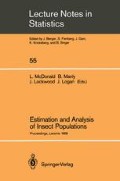Abstract
In this paper I discuss the concept of a composite modeling approach as applied to insect population analysis. A composite model is a term that has been applied to mathematically tractable models that have parameters which were derived in an obvious fashion from more complex, and ecologically meaningful, simulation models. This approach to modeling was motivated by the difficulty in producing models that simultaneously satisfy the requirements of ecological fidelity and mathematical tractability. The modeling paradigm discussed in this paper is to first develop a model that satisfies the requirement of ecological realism. Then, through application of various mathematical procedures and ecological intuition, successively more abstract, simplified models are developed. The final objective is an ecologically credible model amenable to mathematical analysis. I first discuss the problem in general terms and then illustrate its application by a specific problem.
Access this chapter
Tax calculation will be finalised at checkout
Purchases are for personal use only
Preview
Unable to display preview. Download preview PDF.
References
Doedel, E. J., & J. P. Kernevez. 1986. AUTO: Software for continuation and bifurcation problems in ordinary differential equations. Technical Report in Applied Mathematics. California Institute of Technology, Pasadena.
Forrester, J. W. 1961. Industrial dynamics. MIT Press, Cambridge, 464 pp.
Holling, C. S. 1973. Resiliency and stability of ecological systems. Ann Rev. Ecol. Syst.4: 1–24.
Hoyt, S. C. 1969. Integrated chemical control of insects and biological control of mites on apple in Washington. J. Econ. Entomol.62: 74 – 86.
Hoyt, S. C., & L. E. Caltagirone. 1971. The developing programs of integrated control of pests of apples in Washington and peaches in California, pp. 395–421. In C. B. Huffaker [ed.], Biological control. Plenum Press, New York.
Levins, R. 1966. Strategy of model building in population biology. Am. Sci54: 421 – 431.
Logan, J. A. 1977. Population model of the association of Tetranychus mcdanieli(Acarina: Tetranychidae) with Metaseiulus occidentalis(Acarina: Phytoseiidae) in the apple ecosystem. Ph. D. dissertation Washington State University, Pullman.
Logan, J. A. 1982. Recent advances and new directions in Phytoseiid population models, pp. 49–71. In M. A. Hoy [ed.], Recent advances in knowledge of the Phytoseiidae. Agrie. Sci. Pubi. 3284, University of California, Berkeley.
Logan, J. A. 1982. Recent advances and new directions in Phytoseiid population models, pp. 49–71. In M. A. Hoy [ed.], Recent advances in knowledge of the Phytoseiidae. Agrie. Sci. Pubi. 3284, University of California, Berkeley.
Logan, J. A., & D. W. Hilbert. 1983. Modeling the effect of temperature on arthropod population systems, pp. 113–122. InW. K. Lauenroth, G. V. Skogerboe, and M. Flug [eds.], Analysis of ecological systems: state—of—the—art in ecological modeling. Elsevier Sci. Pubi. Co., Amsterdam.
May R. M. 1981. Models for two interacting populations, pp. 8–104. In R. M. May [ed.], Theoretical ecology: principles and applications ( second edition ). Blackwell Sci. Pubi. Co., London.
Miller, D. R., D. E. Weidhass, & R. C. Hall. 1973. Parameter sensitivity in insect population modeling. J. Theor. Biol.42: 263 – 274.
O’Neill, R. V., D. L. DeAngeUs, J. B. Waide, & T. F. H. Allen. 1986. A hierarchical concept of ecosystems. Princeton University Press, Princeton, NJ.
Plant, R. E., & M. Mangle. 1987. Modeling and simulation in agriculture pest management. SIAM Rev. 29: 235 – 261.
Segel, L. A. 1972. Simplification and scaling. SIAM Rev. 14: 547 – 571.
Tanigoshi, L. K., S. C. Hoyt, R. W. Browne, & J. A. Logan. 1975a. Influence of temperature on population increase of Tetranychus mcdanieli(Acarina: Phytoseiidae). Ann. Entomol Soc. Am.68: 972 – 978.
Tanigoshi, L. K., S. C. Hoyt, R. W. Browne, & J. A. Logan. 1975b. Influence of temperature on population increase of Metaseiulus occidentalis(Acarina: Phytoseiidae). Ann. Entomol. Soc. Am.68: 979 – 986.
Wollkind, D. J., J. A. Logan, & A. A. Berryman. 1979. Asymptotic methods for modeling biological processes. Res. Popul. Ecol.20: 49 – 59.
Wollkind, D. J., J. A. Logan, & A. A. Berryman. 1979. Asymptotic methods for modeling biological processes. Res. Popul. Ecol.20: 49 – 59.
Author information
Authors and Affiliations
Editor information
Editors and Affiliations
Rights and permissions
Copyright information
© 1989 Springer-Verlag Berlin Heidelberg
About this paper
Cite this paper
Logan, J.A. (1989). Derivation and Analysis of Composite Models for Insect Populations. In: McDonald, L.L., Manly, B.F.J., Lockwood, J.A., Logan, J.A. (eds) Estimation and Analysis of Insect Populations. Lecture Notes in Statistics, vol 55. Springer, New York, NY. https://doi.org/10.1007/978-1-4612-3664-1_19
Download citation
DOI: https://doi.org/10.1007/978-1-4612-3664-1_19
Publisher Name: Springer, New York, NY
Print ISBN: 978-0-387-96998-5
Online ISBN: 978-1-4612-3664-1
eBook Packages: Springer Book Archive

